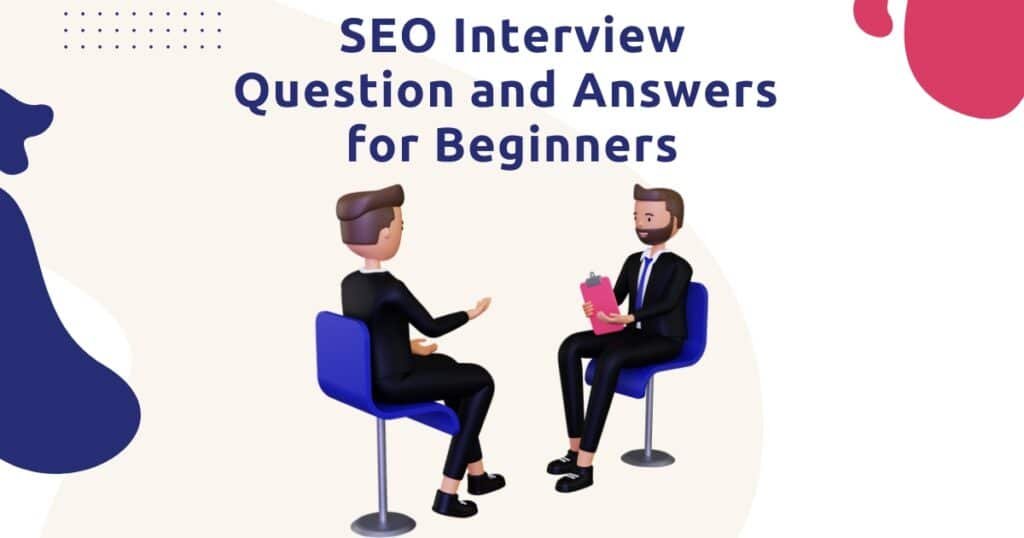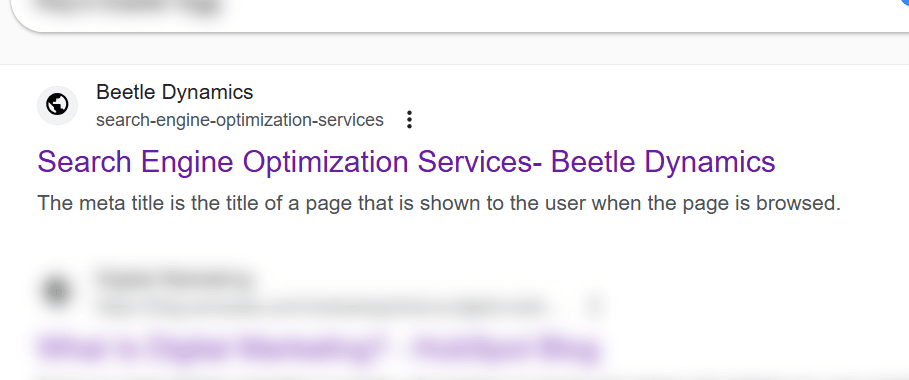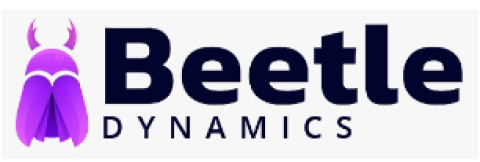SEO Interview Questions and Answers 2025
Google is more than 25 years old but it seems that it has always been here. If you are preparing for your interview, then here are some SEO questions and answers for you which are beneficial for both beginners and experienced. In 2025, Google keeps updating the terms of SEO continuously due to which it has developed to a great extent.
SEO Interview Question and Answers for Beginners
1. What is SEO in 2025?
SEO, also known as Search Engine Optimization, is an organic process through which a website’s visibility is increased on the top of SERPs. Through this technique, any keyword is given top ranking without paying. This is a completely free process.
2. Why is SEO Important for Any Business?
SEO plays a vital role in increasing the visibility of a website or business on search engines. Its main work is to increase traffic on a website and attract related customers towards the website’s services. Which helps in increasing online products and business.
3. What did you Mean About Google Autocomplete?
Whenever we search on Google search bar, it shows us some suggestions that match our keywords. Through this feature, users complete their searches quickly and easily and get the results. This is very useful for SEO because it provides you suggestions based on the queries you search on Google.
4. What is a Domain Name?
If we say in simple words, domain name is the primary name of the website under which we are running it. Like the website on which you are reading SEO Interview Questions and Answers 2025, its domain name is beetledynamics.com. Domain name is that which if someone requests once, then no one else can use the same name.
5. What is the Difference Between Domain Name and Extension?
Domain name is the full name of a website such as:
- beetledynamics.com
- workingment.com
- medium.com
- quora.com and more.
There are several types of domain name extensions available:
- .com
- .in
- .net
- .org
- .edu
- .co
- .shop
- .online
- .wiki
- .cab
- .academy
- .me
- .app
Here is a list of all domain name extensions available for registration.
6. What Are Keywords in SEO?
Keywords are the most common queries searched by users which are related to their product, services or any information. They get searched at the place according to their needs.
Like I am writing an article and its topic is “Best Digital Marketing Agency in Jaipur”. So first of all, for this I will need those Google related searches which are being searched on Google Paralog.
So some keywords for the given topic can be:
- Best digital marketing company in Jaipur
- Social media marketing agency in Jaipur
- Best SEO company in Jaipur
- Best influencer marketing agency in Jaipur
So I will include these given keywords in the content of my webpage so that the user’s query can be matched with my article and traffic can be gained.
7. What is Keyword Density?
Keyword density means how many times a keyword has been used in total words in an article or webpage. If taken as a rough idea, then if I use a keyword 10 times in a content of 1000 words, then the keyword density of that keyword will be 1%. Which is very important for any content.
8. Keyword Density Matters?
Yes, of course it matters a lot in SEO. If we use the same keyword many times in our content, then many times it comes under keyword stuffing and keyword stuffing is not right for any article in search engine optimization. So, it is very important to always keep in mind the right keyword.
9. What did you Know About Keyword Stuffing in SEO?
According to Google, if you use a lot of keywords on a webpage so that the page appears on top for those keywords, this process is called keyword stuffing.
But today, according to the latest terms of SEO, keyword stuffing comes under black hat SEO which has a negative SEO ranking factor. So if you want your content to look natural, you should not add any keyword in your content in a way that it looks forceful.
10. Can you Share an Example of Keyword Stuffing?
Here’s an example of keyword stuffing:
“If you are looking for the best digital marketing agency then our digital marketing agency is the best option. Our digital marketing agency is quite affordable through which you can grow your business.”
Here the digital marketing agency keyword is repeated again and again in a single paragraph. So this is called keyword stuffing in SEO.
11. What is Keyword Difficulty in SEO?
Keyword difficulty means how difficult it is to rank content on the first page of Google using a keyword. If a keyword has low difficulty, it does not require as much effort to rank compared to a keyword with higher difficulty.
12. What are Different Types of Keywords in SEO?
We can categorize keywords in SEO according to their length and intent:
According to Intent:
- Informational keywords
- Navigational keywords
- Commercial keywords
- Transactional keywords
According to Length:
- Short-tail keywords
- Mid-tail keywords
- Long-tail keywords
Other Types:
- Geo-targeted keywords
- LSI keywords
- Long-term evergreen keywords
- Short-term fresh keywords
13. Importance of Keyword Research in SEO?
Keyword research is required in SEO so that the user can find his actual query on search engines like Google and others. If we are optimizing a website, product or content for a search engine, then first of all we have to find the targeting keywords. Only if we use the right keywords, we can get higher ranking and more traffic to our pages.
14. Where can we Use Keywords?
This is the most common question asked in SEO interviews in 2025, you should know how to use the right keywords at the right place. Keywords are used in many different places such as on-page SEO, off-page SEO optimization:
- Meta Title
- Meta Description
- Page Content
- Alt Tags
- Image Optimization
- Subheadings
- URL
- Headings
15. What are Short Keywords in SEO?
Short tail keywords which are also called seed keywords are those which contain one or two words. The monthly search volume of such short tail keywords is very high and the SEO difficulty is also high. These keywords provide relevant ideas to find long tail and mid tail keywords.
For example, “digital marketing” is a seed keyword and relevant keywords for it are “digital marketing agency” or “digital marketing website” etc.
16. What is the Difference Between Long-tail Keywords and Short-tail Keywords?
Both long tail keywords and short tail keywords play a very important role in search engine optimization. Short tail keywords contain 1-2 words and on the contrary long tail keywords contain more than 3 words. If the domain authority of a website is low then through long tail keywords you can easily increase the ranking and get traffic.
Examples:
- What Are the Different Types of SEO in Digital Marketing?
- Best mobile phone under 10000
- How to make white sauce pasta?
- Best digital marketing agency
17. What is the Bounce Rate?
Bounce rate means the rate of visitors who come to a website and leave that page without taking any action.
For example, a blog has been published on a website and it is getting good traffic but users come and go without clicking on any link or other links present in that page, hence they get high bounce rate.
18. What is Sitemap?
A sitemap is a file that tells Google’s crawler about the URL of the website you want to crawl. It acts like a link map of the site. Google or other search engines read these files and understand their structure. A sitemap file contains the URLs of websites and webpages that can get maximum traffic.
19. Why is Sitemap Needed for SEO?
Through sitemap, we can easily navigate the search engine so that it can crawl and index all the URLs. Due to which the crawling speed increases which is very good for search engine optimization.
If you have a small website in which all the URLs are available in menu, footer etc. then Google easily crawls it and ranking is easily achieved, but on the contrary, if your website has hundreds of pages and your website is big, then sitemap becomes very important for it. So that Google can easily crawl those pages.
20. What is Robots.txt?
Robots.txt is a file through which instructions are given to the bots of Google or other search engines on how to crawl and index the website and its pages.
This file is in the format of .txt which contains only text and no HTML codes. Its main motive is to tell the search engine bots to avoid unnecessary visits. This is the first file which the crawlers visit.
21. What are Meta Tags in SEO?
Meta tags are snippets of HTML codes and are used to structure any on-page content so that Google and other search engines can tell about the content.
For example, we can use meta title to tell the search engine which page is to be shown on top of the SERP. Every page of every website has meta tags which are part of a code and are not shown to the user.
Some Primary Meta Tags Used in SEO:
- Meta Title
- Meta Description
- Meta robots
- Meta Viewport
22. Do Meta Tags Help in SEO?
Yes, meta tags are very useful for search engine optimization. Because these tags tell the search engine which title and description to show on Google and how to structure the content.
But keep one thing in mind that meta tags do not always help in SEO.
23. What are Meta Keywords in SEO?
Meta keywords are similar to meta tags but they are not used nowadays. In the olden times, meta keywords were used in SEO to give the search engine the intent of the page.
24. What is Meta Title in SEO?
Meta title is the title of a page which is shown to the user when that page is shown in SERP. It is also called title tag which is shown on the user’s browser tab. For example, if our web page’s meta title is search engine optimization services, then it will appear like this on the search engine:
25. What is Meta Description?
Meta description is a short summary of a page that tells the intent of the page to the user. It is displayed immediately after the meta title on the SERP and helps the user to know what is written on this page and whether it is according to their expectations or not, which the user agrees to click.
Interview Questions for SEO Executive
If you are in the field of SEO for 1 or 2 years then the SEO executive interview questions and answers given below are highly relevant for you. By solving these questions you can easily crack any interview.
1. What are the Top Ranking Factors in SEO in 2025?
There are some such SEO ranking factors which are very important to optimize any website on Google through which your website comes on top ranking.
Here are some factors which are very important for ranking any website in 2025:
- Use relevant keywords
- High- quality content
- Website load speed
- SSL certificate
- Mobile Friendly
- Quality Backlinks
- Meta title and description
- Repair broken links
- SEO URLs
- Sitemap
- Domain Authority
- Low bounce rate
2. Google Autocomplete Working process?
Whenever a user enters his query on Google search engine, this platform understands his language and interest and answers his query. Based on these factors, Google provides suggestions according to his query.
Google suggests us autocomplete through search which helps us to search easily on Google and it also helps us to find long tail keywords.
3. What is ccTLD?
ccTLD (Country Code Top Level Domain) These are domain name extensions which are generally used for international websites. They are used by those who want to target customers of a specific country.
Here are some ccTLD examples:
- .in
- .ae
- .ca
- .eu
- .au
- .cn
- .ru
- .jp
4. What is International SEO?
International search engine optimization is used when a business has to optimize its website for a country or specific region. So that users can come to it. For example, if a website is getting more traffic from India, then we have to optimize our website for better user experience, for which we will use .in TLD in which we will publish blogs in Hindi language and will use tags of specific languages. There are some country specific domains:
- noname.in
- in.noname.com
- noname.com/in
5. What is Good Keyword Density?
Google does not have any fixed rule for keyword density, meaning it is not stated how many times a keyword can be used and how many times it should be repeated.
But SEO experts suggest that the keyword density in any blog should be between 1 and 2% which provides a better score to the SEO, for example, if you have a blog and it has 200 words, then it is good to use keywords 2 to 4 times in it, which also avoids keyword stuffing and increases the user’s interest. So we can assume that 2% can be considered a good keyword density.
6. How to Check Keyword Density?
There is a simple formula to check keyword density, according to which, by dividing the number of times a keyword has been used by the total word count and multiplying the result by 100, you get the keyword density.
Formula: Keyword Density = (Total used Keywords/ Total Words)* 100
7. Best Keyword Density Checker Tools
There are many keyword density checkers available online but here are some options that are quite reliable:
- MOZBar
- Pre Post SEO
- Small SEO Tools
- Copywritely
8. What does a Keyword Difficulty Score Mean?
Keyword difficulty tells us how difficult it will be for us to rank the keyword on which we are working or want to rank and bring it to the top ranking.
The ranking of the keyword used by us depends on the score, how many websites have worked on that keyword, what is the domain authority of those websites and what is the quality of their content which is ranking.
9. Which Keyword Difficulty Score is Good?
The score of keyword difficulty depends on the authority of the website, for example, if there is a website and its DA is low, then we cannot use keywords with high KD, there it would be better to use low difficulty keywords and as their ranking improves, we can use keywords with high keyword difficulty.
But if the domain quality of your website is high and it has good traffic and the content is also good, then we can work on high difficulty keywords and achieve ranking.
The direct conclusion from this is that one should first start with easy keywords and then use high difficulty keywords.
10. Difference Between Low, Medium and High Keyword Difficulties?
Keyword difficulty has a score of 1 to 100 which we divide as follows:
- Low: 1 to 29
- Medium: 30 to 70
- High: 71 to 100
11. What is Keyword Frequency in SEO?
Keyword frequency concept is similar to keyword density, it means how many times a keyword is used in any content. If it is used more times then its frequency is high and if it is used less then its frequency is low. Its main purpose is to make the search engine understand about our web page that what we want to tell in it.
12. How Many Keywords Should We Use in an Article?
How many keywords to use in an article depends on the word count of that article. For example, if our article has 1000 words, then we have to use a keyword 10 to 20 times because if it is more than this, it can lead to keyword stuffing because we have to keep the keyword density 1-2%. But we have to use these keywords naturally.
13. How to find Long-tail Keywords? Some Tips and Tools:
There are many types and tools to search for long-tail keywords such as:
- Google Autocomplete
- Related Search section
- Keyword research tools such as SEMrush, Ahrefs, Ubersuggest. In these tools, you get questions related to long tail keywords.
- Answer the public
- Quora
14. What are Geo-Targeted Keywords?
When a keyword is used by targeting a particular location then it is called a geo targeted keyword.
For example: Our keywords are “digital marketing agency in Jaipur” or “WhatsApp marketing services in Jaipur”. These keywords describe local search intent so they will be called geo targeted keywords.
15. What are Navigational Keywords?
These keywords mean that a user asks to direct to the service pages or web pages of a website.
Example:
- Beetle Dynamics SEO services
- SEMrush Keyword Overview
- Website Hosting by Hostinger
16. Does Bounce Rate Affect SEO?
Yes, bounce rate has a huge impact on SEO. For example, if a user visits our web page or website and leaves the page without doing any activity, it simply means that the user is not interested in our content. If people do this more often, Google focuses on user experience and a high bounce rate has a negative impact on SEO.
17. What is the Formula of Bounce Rate? And How to Calculate it?
Bounce Rate = (No. of visitors leaving without action / total page visits) * 10
Example:
If 500 people are visiting a page and 300 people leave that page without taking any action then our bounce rate will be (300/500)*100= 60%.
18. What are the Main Reasons for the High Bounce Rate?
There can be several reasons for a high bounce rate:
- Slow page speed
- Not using proper internal links
- Meta title mislead
- Content quality
- Only landing page
19. What is a Session in Google Analytics?
Session means for how long a user stays on a website or is active. If a user visits the website within these 30 minutes then we count him in the same session but if you come back to the website after 30 minutes or do any activity then it will be counted in a new session.
For example: if a session takes a total 1000 seconds and there have been 25 sessions then the average time of the session is 40 seconds.
20. What is Dwell Time in SEO?
Dwell time is when a user comes to your page by clicking on a link from Google or any other platform and the page appears on the SERP. The time taken in between all this is called dwell time. It all depends on the quality of the content of our web page. If the content is good then the user stays otherwise the page moves on immediately.
21. How to Create Sitemap For Any Website?
If our website is small then we can create it manually on notepad. But if you want to make it easy and effective then there are many sitemap generators on Google which create sitemaps for you like XML-sitemaps.com and My Sitemap Generator. If your website is built on WordPress then there are plugins for it which create a free sitemap that too automatically.
22. How Many Metrics are Important in SEO?
Here are some metrics you should know:
- Primary Keywords ranking
- Total Clicks
- Core Web Vitals
- Referring Domains
- Website Traffic check
- CTR(Click- through rate)
- Conversion Rate
- Bounce Rate




